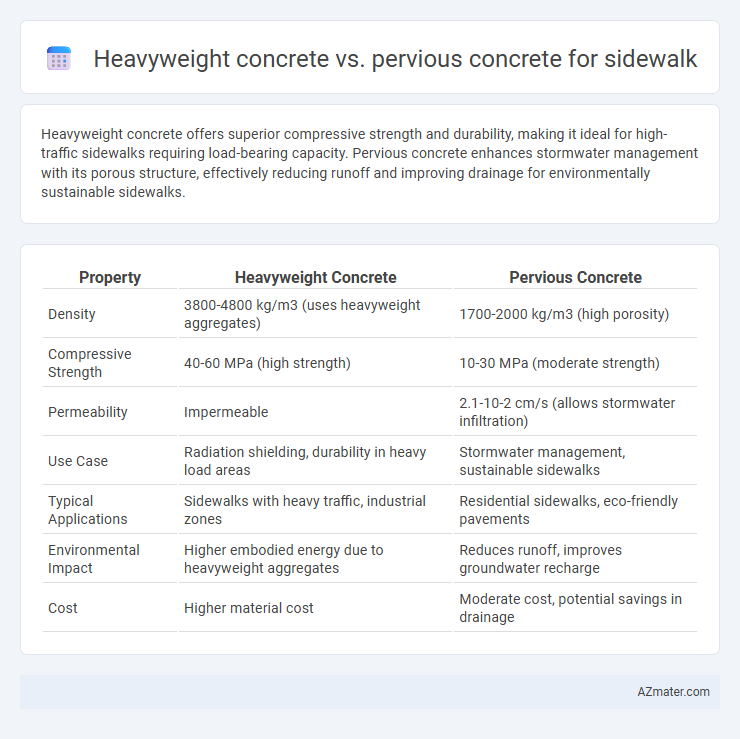Heavyweight concrete offers superior compressive strength and durability, making it ideal for high-traffic sidewalks requiring load-bearing capacity. Pervious concrete enhances stormwater management with its porous structure, effectively reducing runoff and improving drainage for environmentally sustainable sidewalks.
Table of Comparison
| Property | Heavyweight Concrete | Pervious Concrete |
|---|---|---|
| Density | 3800-4800 kg/m3 (uses heavyweight aggregates) | 1700-2000 kg/m3 (high porosity) |
| Compressive Strength | 40-60 MPa (high strength) | 10-30 MPa (moderate strength) |
| Permeability | Impermeable | 2.1-10-2 cm/s (allows stormwater infiltration) |
| Use Case | Radiation shielding, durability in heavy load areas | Stormwater management, sustainable sidewalks |
| Typical Applications | Sidewalks with heavy traffic, industrial zones | Residential sidewalks, eco-friendly pavements |
| Environmental Impact | Higher embodied energy due to heavyweight aggregates | Reduces runoff, improves groundwater recharge |
| Cost | Higher material cost | Moderate cost, potential savings in drainage |
Introduction to Heavyweight and Pervious Concrete
Heavyweight concrete is a dense mixture primarily composed of heavyweight aggregates like magnetite or barite, offering superior radiation shielding and enhanced structural stability for sidewalks in high-stress environments. Pervious concrete incorporates a porous structure with interconnected voids that facilitate rapid water infiltration, reducing surface runoff and improving stormwater management on pedestrian pathways. Selecting between heavyweight and pervious concrete involves evaluating factors such as load-bearing requirements, environmental drainage needs, and site-specific conditions.
Key Material Composition Differences
Heavyweight concrete contains dense aggregates such as barite, magnetite, or hematite, significantly increasing its density and radiation shielding properties, making it ideal for specialized infrastructure. Pervious concrete incorporates a high percentage of coarse aggregates with minimal fine aggregates and cement paste, creating a porous structure that facilitates water drainage and reduces surface runoff for sidewalks. The key material composition difference lies in heavyweight concrete's dense, fine-grained aggregates versus pervious concrete's porous aggregate matrix designed for permeability.
Strength and Durability Comparison
Heavyweight concrete, known for its high density and compressive strength typically ranging from 4000 to 6000 psi, offers superior durability and resistance to heavy loads, making it ideal for sidewalks exposed to substantial traffic or harsh environmental conditions. In contrast, pervious concrete, with compressive strength usually between 2000 and 4000 psi, prioritizes permeability over strength, allowing water to pass through and reducing surface runoff but offering less resistance to wear and mechanical stress. The choice between heavyweight and pervious concrete for sidewalks depends on the balance between required structural strength and stormwater management needs, with heavyweight concrete excelling in load-bearing capacity and longevity while pervious concrete enhances environmental sustainability through effective drainage.
Permeability and Drainage Capabilities
Pervious concrete offers superior permeability and drainage capabilities compared to heavyweight concrete, allowing water to pass through its porous structure and reduce surface runoff on sidewalks. Heavyweight concrete's dense composition limits water flow, making it less effective for managing stormwater and increasing the risk of pooling and flooding. For urban sidewalks requiring efficient drainage and permeability to enhance safety and environmental sustainability, pervious concrete is the optimal choice.
Suitability for Urban Sidewalk Applications
Heavyweight concrete offers exceptional durability and load-bearing capacity, making it suitable for urban sidewalks subjected to heavy foot traffic and occasional vehicular loads such as maintenance vehicles. Pervious concrete enhances urban sustainability by promoting stormwater infiltration, reducing runoff and urban flooding, but it has lower compressive strength and may require more frequent maintenance in high-traffic areas. Selecting between heavyweight and pervious concrete depends on balancing structural demands with environmental benefits for specific urban sidewalk applications.
Environmental Impact and Sustainability
Heavyweight concrete, composed of dense aggregates like magnetite or barite, offers durability but has a higher carbon footprint due to energy-intensive materials and production processes. Pervious concrete enhances sustainability by facilitating stormwater infiltration, reducing runoff, and replenishing groundwater, thus mitigating urban heat island effects and improving water quality. Choosing pervious concrete for sidewalks promotes environmental benefits through reduced pollution and better water management, aligning with green infrastructure goals.
Installation and Maintenance Requirements
Heavyweight concrete requires precise mixing and skilled labor due to its high density and specialized aggregates, while pervious concrete demands careful layering and compaction to maintain its porous structure and permeability. Maintenance for heavyweight concrete remains low, focusing primarily on occasional surface cleaning and crack repairs, whereas pervious concrete necessitates regular vacuuming or pressure washing to prevent clogging and ensure consistent water infiltration. Proper installation of both types is essential to maximize longevity, with heavyweight concrete suited for high-load areas and pervious concrete ideal for stormwater management on sidewalks.
Cost Analysis: Initial and Long-term Expenses
Heavyweight concrete typically incurs higher initial costs due to increased material density and specialized aggregates, but its durability reduces long-term maintenance expenses. Pervious concrete offers lower installation costs and promotes stormwater management, yet may result in higher upkeep costs from potential clogging and reduced lifespan. Analyzing cost-efficiency requires balancing upfront investment against projected maintenance and environmental benefits specific to sidewalk applications.
Safety and User Comfort Factors
Heavyweight concrete, known for its density and durability, offers enhanced load-bearing capacity and improved slip resistance, making it a safer option for sidewalks in high-traffic or industrial areas. Pervious concrete provides superior water drainage, reducing surface water accumulation and minimizing the risk of hydroplaning or slipperiness during wet conditions, which enhances user comfort and safety. However, pervious concrete's porous nature may require more maintenance to prevent clogging and maintain its safety benefits over time compared to the low-maintenance, robust structure of heavyweight concrete.
Choosing the Right Concrete for Sidewalk Projects
Heavyweight concrete offers exceptional durability and excellent load-bearing capacity, making it ideal for sidewalks subject to heavy pedestrian traffic or occasional vehicular loads. Pervious concrete enhances water drainage and reduces runoff, promoting environmental sustainability and preventing surface water accumulation on sidewalks. Selecting the right concrete depends on project priorities such as structural strength requirements versus ecological benefits, with heavyweight concrete favored for strength and pervious concrete chosen for superior permeability.

Infographic: Heavyweight concrete vs Pervious concrete for Sidewalk
 azmater.com
azmater.com